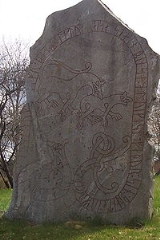
Uppland Rune Inscription 35
Encyclopedia
This memorial runestone, listed as U 35 under Rundata
, is located in Svartsjö, Uppland
, Sweden
, and dates from the Viking Age
.
is unknown, and the stone is classified as being in runestone style Pr2, which is also known as the Ringerike style
.
The name Adils or Aðísl from the runic text appears to have been a rather rare name, during both the Viking Age and the Middle Ages
. It does not appear in any other Swedish runic inscription. The name does appear in Ynglingatal
, Norse saga
s, and Beowulf
as belonging to a Swedish king during the sixth century named Eadgils
. It also appears on one of the Manx Runestones
, Kirk Michael MM 130.
The runic text states that the stone is a memorial by three sons to their father Vigisl, who is described as being the husband of Ärnfrids. By referring to her in this manner, the text is probably indicating that she was also deceased when the stone was raised.
Rundata
The Scandinavian Runic-text Data Base is a project involving the creation and maintenance of a database of runic inscriptions. The project's goal is to comprehensively catalog runestones in a machine-readable way for future research...
, is located in Svartsjö, Uppland
Uppland
Uppland is a historical province or landskap on the eastern coast of Sweden, just north of Stockholm, the capital. It borders Södermanland, Västmanland and Gästrikland. It is also bounded by lake Mälaren and the Baltic sea...
, Sweden
Sweden
Sweden , officially the Kingdom of Sweden , is a Nordic country on the Scandinavian Peninsula in Northern Europe. Sweden borders with Norway and Finland and is connected to Denmark by a bridge-tunnel across the Öresund....
, and dates from the Viking Age
Viking Age
Viking Age is the term for the period in European history, especially Northern European and Scandinavian history, spanning the late 8th to 11th centuries. Scandinavian Vikings explored Europe by its oceans and rivers through trade and warfare. The Vikings also reached Iceland, Greenland,...
.
Description
The inscription on this granite runestone, which is three meters in height, has two fanged beasts surrounded by a runic serpent text band. The name of the runemasterRunemaster
A runemaster or runecarver is a specialist in making runestones.Most early medieval Scandinavians were probably literate in runes, and most people probably carved messages on pieces of bone and wood. However, it was difficult to make runestones, and in order to master it one also needed to be a...
is unknown, and the stone is classified as being in runestone style Pr2, which is also known as the Ringerike style
Ringerike style
The Ringerike style is a Scandinavian animal style from the late 10th century and the 11th century, which evolved out of the earlier Mammen style. It has received its name from a group of runestones with animal and plant motifs in the Ringerike district north of Oslo. The most common motifs are...
.
The name Adils or Aðísl from the runic text appears to have been a rather rare name, during both the Viking Age and the Middle Ages
Middle Ages
The Middle Ages is a periodization of European history from the 5th century to the 15th century. The Middle Ages follows the fall of the Western Roman Empire in 476 and precedes the Early Modern Era. It is the middle period of a three-period division of Western history: Classic, Medieval and Modern...
. It does not appear in any other Swedish runic inscription. The name does appear in Ynglingatal
Ynglingatal
Ynglingatal is a skaldic poem listing the kings of the House of Ynglings, dated by most scholars to the late 9th century.The original version is attributed to Þjóðólfr af Hvini who was the skald of a Norwegian petty king named Ragnvald the Mountain-High and who was a cousin of Harald Fairhair...
, Norse saga
Norse saga
The sagas are stories about ancient Scandinavian and Germanic history, about early Viking voyages, the battles that took place during the voyages, about migration to Iceland and of feuds between Icelandic families...
s, and Beowulf
Beowulf
Beowulf , but modern scholars agree in naming it after the hero whose life is its subject." of an Old English heroic epic poem consisting of 3182 alliterative long lines, set in Scandinavia, commonly cited as one of the most important works of Anglo-Saxon literature.It survives in a single...
as belonging to a Swedish king during the sixth century named Eadgils
Eadgils
Eadgils, Adils, Aðils, Adillus, Aðísl at Uppsölum, Athisl, Athislus or Adhel was a semi-legendary king of Sweden, who is estimated to have lived during the 6th century....
. It also appears on one of the Manx Runestones
Manx Runestones
The Manx runestones were made by the Norse population on the Isle of Man during the Viking Age, mostly in the 10th century. Despite its small size, the Isle of Man stands out with many Viking Age runestones, in 1983 numbering as many as 26 surviving stones, which can be compared to 33 in all of...
, Kirk Michael MM 130.
The runic text states that the stone is a memorial by three sons to their father Vigisl, who is described as being the husband of Ärnfrids. By referring to her in this manner, the text is probably indicating that she was also deceased when the stone was raised.
Inscription
A transliteration of the runic text into Latin letters is:- aþisl : auk : ays- : auk : ---fr : þaiR : litu : raisa : stain : þinsa : at : uikisl : faþur : sin : boanta : irfriþaR

